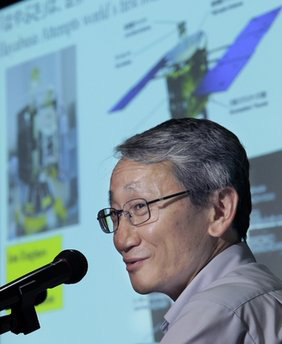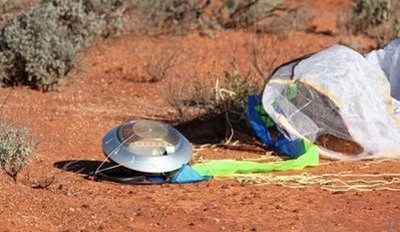-
News >World
Japanese spacecraft may have dust from asteroid
2010-07-08 11:47
Hayabusa probe asteroid exploration project chief Kawaguchi of Japan Aerospace Exploration Agency (JAXA) speaks during a press conference in Tokyo, Japan, Wednesday, July 7, 2010. [Agencies]
TOKYO - Japanese scientists say they have detected tiny particles collected by the first spacecraft to return to Earth after landing on an asteroid. But determining if the dust came from the asteroid or was picked up by the spacecraft on its return trip could take months.
Material found in the Hayabusa spacecraft's sample collection compartments could offer insight into the creation and makeup of the solar system.
The capsule landed successfully in the Australian Outback last month after a seven-year, 4-billion mile (6-billion kilometer) journey despite a series of technical glitches that raised worries that the mission could fail.Project chief Junichiro Kawaguchi said Wednesday a small number of mostly microscopic particles were found and dust from the asteroid was likely among them. But he said it was also suspected that contaminants from Earth may have been mixed in.
"We need to determine their origin," he said, adding that could take months.
Experts from NASA and Australia are also involved in the project.
Hayabusa, launched in 2003, reached an asteroid called Itokawa in 2005. After taking photos from all angles of the 1,640-foot (500-meter) -long asteroid, Hayabusa landed on it twice in November 2005. The spacecraft then limped home after developing a fuel leak and losing contact with Earth for seven weeks.
It was the first spacecraft ever to successfully land on an asteroid and then return home.

The capsule carried by the Japanese Hayabusa spacecraft is shown after it parachuted back to land before being retrieved within the Woomera military zone in the Australian Outback, file photo. [Agencies]
The craft was designed to shoot a bullet into the surface of the asteroid that would crush and propel material through a long tube into a sample collection container. There is no certainty the bullet actually fired, scientists say, but they believe the impact of the tube's landing would have forced some material upward and into the collection chamber.
JAXA, the Japanese space agency, said the aim of the $200 million project was to understand more about the origin and evolution of the solar system. Scientists hope to study how and when the asteroid was formed, its physical properties, what other bodies it may have been in contact with, and how solar wind and radiation have affected it.
Kawaguchi said the successful collection of samples from an asteroid could be used as a building block for future efforts to mine minerals or other resources from planets and bring them back for use on Earth. He said Japan is already considering another asteroid mission.
"This is a first step," he said. "Continuing with what we have learned from this project will be important to build on our knowledge."
If Hayabusa is indeed carrying asteroid samples, it would be only the fourth set of space samples returned in history - including moon matter collected by the Apollo missions, comet material by Stardust, and solar matter from the Genesis mission.
